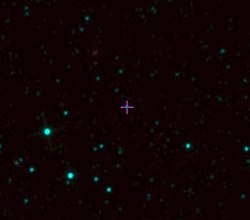 Context star field of ASASSN-V J213939.3-702817.4 | |
| Observation data Epoch J2000 Equinox J2000 | |
|---|---|
| Constellation | Indus |
| Right ascension | 21 39 39.3 |
| Declination | −70° 28′ 17.4″ |
| Characteristics | |
| Spectral type | F0V |
| Astrometry | |
| Distance | 3630±110 ly (1113±33 pc) |
| Absolute magnitude (MV) | 2.5 |
| Details | |
| Temperature | 6800±110 K |
| Other designations | |
| 2MASS ASAS-SN-V J213939.3-702817.4, J213939.3-702817.4 | |
| Database references | |
| SIMBAD | data |
ASASSN-V J213939.3-702817.4 (also known as ASAS-SN-V J213939.3-702817.4 and J213939.3-702817.4) is a star, previously non-variable, found to be associated with an unusual, deep dimming event that was uncovered by the All Sky Automated Survey for SuperNovae (ASAS-SN) project, and first reported on 4 June 2019 in The Astronomer's Telegram.

The star, in the constellation of Indus, about 3,630 ± 110 light-years (1,113 ± 33 pc) away, was first observed on 15 May 2014 (UT) by ASAS-SN, and, as of 4 June 2019, has resulted in more than 1780 data points, including a quiescent mean magnitude of g~12.95. On 4 June 2019, the star was reported to have dimmed gradually from g~11.96 at HJD 2458635.78, to g~14.22 at 4458837.45, and, as of 4 June 2019, seems to be returning to its quiescent state of g~13.29 at HJD 2851634.89. According to astronomer Tharindu Jayasinghe, one of the discoverers of the deep dimming event, " been quiescent for so long and then suddenly decreased in brightness by a huge amount ... Why that happened, we don't know yet."
See also
References
- Staff (2 August 2008). "Finding the constellation which contains given sky coordinates". DJM.cc. Retrieved 8 June 2019.
- ^ Jayasinghe, T.; et al. (4 June 2019). "ASAS-SN Discovery of an Unusual, Deep Dimming Episode of a Previously Non-Variable Star". The Astronomer's Telegram. Retrieved 8 June 2019.
- ^ McCollum, B.; Laine, S. (8 June 2019). "Spectral Type of the Unusual Variable ASASSN-V J213939.3-702817.4". The Astronomer's Telegram. Retrieved 8 June 2019.
- ^ Seidel, Jamie (6 June 2019). "A suddenly dimming star has caught the attention of alien hunters". The Advertiser. Retrieved 8 June 2019.
- "All-Sky Automated Survey for Supernovae". All-Sky Automated Survey for Supernovae. The Ohio State University. Retrieved 28 October 2024.
- Gilster, Paul (5 June 2019). "HD 163296: Emerging Insights into Circumstellar Disks - Comment (Harry R Ray on 5 June 2019, 9:56)". Centauri-Dreams.org. Retrieved 8 June 2019.
External links
- Video (13:46) − "Tabby's Star" on YouTube, a presentation by Tabetha S. Boyajian (2016).
- Video (31:00) − "Tabby's Star" on YouTube, a presentation by Issac Arthur (2016).
- Video (01:00) − RZ Piscium on YouTube, star with unusual light fluctuations (2017).
- Video (00:13) – EPIC 204376071 on YouTube, up to 80% dimming (2019).
| Constellation of Indus | |||||||||
|---|---|---|---|---|---|---|---|---|---|
| Stars |
| ||||||||
| |||||||||
| Galaxies |
| ||||||||
| |||||||||
| |||||||||